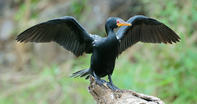
Name
CormorantLatin Family Name
PhalacrocoracidaeAppearance
Cormorants are often referred to as sea crows because of their black colouration. The family name, Phalacrocoracidae, means bald raven in Greek. Cormorants appear black but they are in fact a variety of dark colours ranging from green and violet to ultramarine and bronze.
During breeding time these large seabirds have intensely bright patches around their eyes and throat, which occur in a variety of specific colours. Cormorants are 63 to 101 cm in length, have a distinctive long hooked bill and a gular sac (throat pouch).
This gular sac acts as a holding area for larger prey, helps the bird rid itself of extra heat while panting, and in the breeding season, the bright colours are used for courtship displays. Although their large feet make these birds exceptional swimmers, they are not elegant walkers.
Often the feet overlap and this clumsiness has led to many broken eggs. The structural characteristics that make cormorants such excellent swimmers also affect their flying ability.
The massive thigh and hip muscles that give them strong underwater propulsion make them heavy in relation to the surface area of their wings. It is these characteristics that keep these large birds close to their roosts.
Cormorant Diet
Found in both fresh and salt water, their diet consists mostly of fish, but small amphibians and crustaceans are also consumed.Cormorant Breeding
Cormorants nest in colonies in South Africa. The nest is a well-made platform of sticks or seaweed cemented together with guano and placed in a tree, on a cliff or rocky island. They will often use the same nest each year and the female lay 3-5 chalky, pale blue-green eggs.Cormorant Behaviour
Despite spending much time in the water, cormorants do not possess the same waterproofing oil as other seabirds and spend much time drying their wings.
They use traditional sites for roosting and nesting and the droppings at these sites can build up for years. Cormorants are clumsy on land and form colonies on offshore islets or steep cliffs to protect them from predators. Sometimes they build nests (or use old heron nests) in bare dead trees standing in water or perched on inaccessible cliffs.
Habitat
Cormorants prefer lakes, rivers, swamps and coasts, but do not venture too far out to sea. In South Africa, cormorants are found almost everywhere that water meets the shore.
 SouthAfrica.co.za provides informative, educational content on many South African bird species that orthologists and bird-watchers would enj...
SouthAfrica.co.za provides informative, educational content on many South African bird species that orthologists and bird-watchers would enj... In South Africa the Cape cormorant is a winter visitor to the KwaZulu-Natal coast. It is an endemic resident along the entire south-western ...
In South Africa the Cape cormorant is a winter visitor to the KwaZulu-Natal coast. It is an endemic resident along the entire south-western ... The crowned cormorant prefers rocky coastlines, coastal islands and occasionally lagoons....
The crowned cormorant prefers rocky coastlines, coastal islands and occasionally lagoons.... The white-breasted cormorant breeds throughout the year in South Africa. The peak periods are August or January in the Cape and March to Oct...
The white-breasted cormorant breeds throughout the year in South Africa. The peak periods are August or January in the Cape and March to Oct...